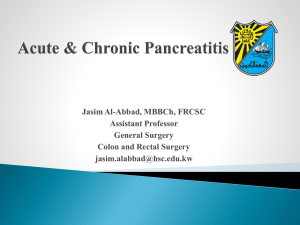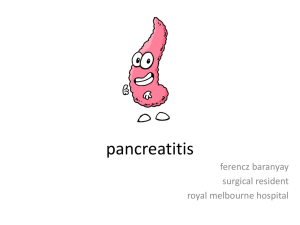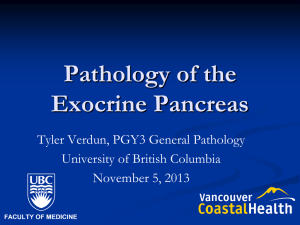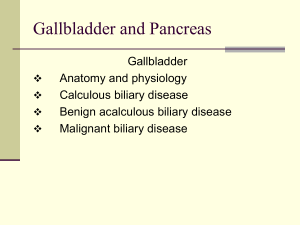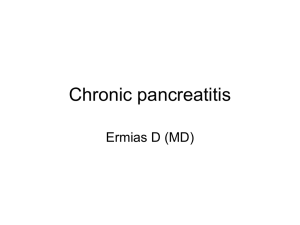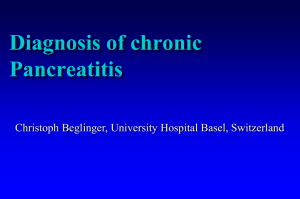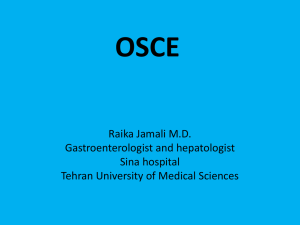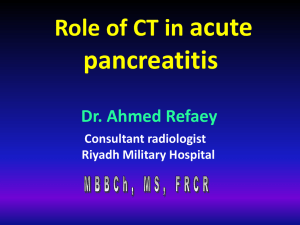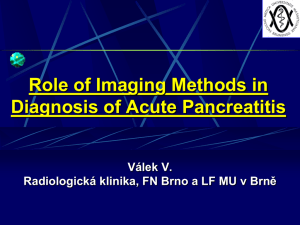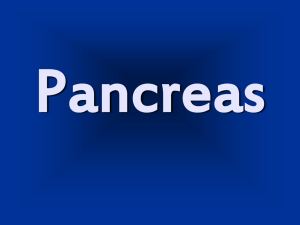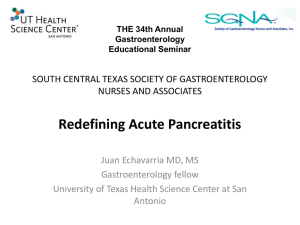Acute pancreatitis
advertisement
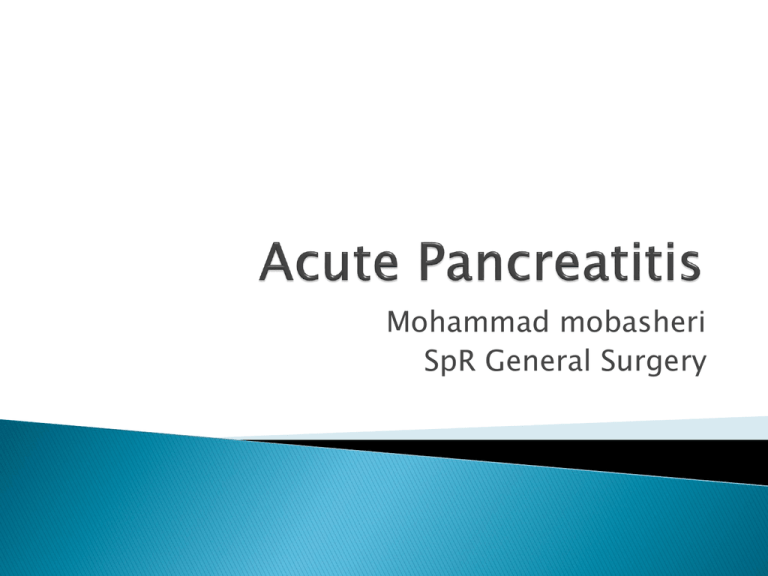
Mohammad mobasheri SpR General Surgery Exocrine Acinar cells – produce digestive enzymes and bicarbonate Endocrine ◦ Islets of Langerhans – contain 4 main cell types Alpha cells – glucagon Beta cells – insulin Delta cells – somatostatin PP cells – pancreatic polypeptide Retroperitoneal Lies between the aorta and the stomach 5 parts: Head Neck Body Tail Uncinate Process Head lies in C shape of duodenum Superior mesenteric artery (arising from aorta which sits posterior to pancreas) and vein pass between head and uncinate process of pancreas and give off branches that enter the small bowel mesentery Tail is in contact with the spleen Blood supply to the pancreas arises from coeliac axis (foregut) and superior mesenteric artery (midgut) Superior Pancreatico-duodenal artery (arises from gastroduodenal artery which is a branch of the common hepatic artery which arises from coeliac trunk) Inferior Pancreatico-duodenal artery (arises from SMA) Pancreatic branches of splenic artery supply neck, body and tail: largest of these is called the arteria pancreatic magna (aka great pancreatic artery). Acute pancreatitis Rapid onset inflammation of the pancreas Chronic pancreatitis Long-standing inflammation of the pancreas G – gallstones E – ethanol (alcohol) T – trauma S – steroids M – mumps and other viruses (EBV, CMV) A – auto-immune (Polyarteritis nodosa, SLE) S – scorpion/snake bite H – hypercalceamia, hypertriglyceridaemia, hypothermia E – ERCP D – drugs (SAND: steroids and sulphonamides, azothioprine, NSAIDS, diuretics [loop/thiazide]) Pancreatic enzymes become activated within the pancreas Autolysis Inflammation/pain/complications Worst offender is trypsin (protease) Oedematous pancreatitis heamorrhagic pancreatitis necrotic pancreatitis (+/superceeding infection: aka infected necrosis) Symptoms Epigastric pain radiating into the back, often eased by sitting forward N&V (vomiting +++) Fevers Signs Haemodynamic instability (tachycardic, hypotensive) Peritonism in upper abdomen/generalised Grey-turners sign (bruising in flanks) Cullens sign (bruising around umbilicus) Grey turners and cullens signs are seen in heamorrhagic pancreatitis Differentials for upper abdominal pain include: Gallstone disease and associated complications (E.g. Biliary colic/acute cholecystitis) Peptic ulcer disease/perforation Leaking/ruptured AAA Blood tests Amylase/lipase (other causes of increased amylase include parotitis, renal failure, macroamylasaemia, bowel perforation, lung/ovary/pancreas/colonic malignancy can produce ectopic amylase) X rays – ECXR, AXR (sentinal loop, gallstone) USS – look for gallstones as cause for pancreatitis CT abdomen (patients not settling with conservative management, and only after 48hrs of symptom onset) MRCP – If you suspect pancreatitis is due to gallstone that is stuck in the CBD ERCP – To remove a gallstone in the CBD that has caused panreatitis Pancreatitis can be life threatening. Pancreatitis classified into mild and severe based on scoring systems: ◦ Modified Glasgow criteria (alternative is Ransons criteria): P – PO2 <8KPa A – age >55yrs N – WCC >15 C – calcium <2mmol/L R – renal: urea >16mmol/L E – enzymes: AST >200iu/L, LDH >600iu/L A – Albumin <32g/L S – sugar >10mmol/L Score of 3 or more within 48hrs of onset suggests severe pancreatitis CRP is an independent predictor of severity, and if >200 is suggestive of severe pancreatitis Other scoring systemics include: Glasgow (non-modified) and Ransons criteria which measure factors at admission and then after 48 hours. ABC 4 Priniciples of management include: Fluid resuscitation (IVF, catheter, strict FB monitoring) Analgesia Pancreatic rest (+/- nutritional support if prolonged recovery [NJ feeding or TPN]) Determining underlying cause 95% settle with conservative treatment If severe pancreatitis on scoring HDU Antibiotics controversial commence if necrotic pancreatitis/infected necrosis, but not routinely. Surgery only very rarely required Systemic Hypocalcaemia (release of lipase results in free fatty acids which chelate calcium salts reducing serum levels: this process of calcium chelation is called saponification) Hyperglycaemia (diabetes if significant beta cell damage) SIRS ARF ARDS DIC MOF and death Acute pancreatitis can be life threatening in severe cases due to SIRS which can progress to multi-organ failure SIRS – overzealous inflammatory response resulting in widespread activation of inflammatory cascades and micro-circulatory dysfunction (believed to be mediated by TNF-alpha) • Temp <36oC, >38oC • HR >90 • RR >20 • WCC >12 • SIRS if 2 or more of the above SIRS frequently complicated by failure of one or more organ systems Acute lung injury (ARDS) Acute kidney injury (ARF) DIC Mutli-organ failure SIRS may be infective (SIRS + source of infection = sepsis) or non infective in origin. Non-infective causes include Trauma Burns Acute Pancreatitis Ischaemia Local Pancreatic necrosis (aka necrotic pancreatitis) +/- infection (infected necrosis) Pancreatic Abscess Pancreatic Pseudocyst Haemorrhage: due to bleeding from eroded vessels Small vessels haemorrhagic pancreatitis with cullens/grey turners sign Large vessels (e.g. Splenic artery) life threatening bleed (unless forms pseudoaneurysm) Thrombosis of splenic vein, SMV, portal vein (in order of frequency) with consequent ascites or small bowel venous congestion/ischaemia Chronic pancreatitis/pancreatic insufficiency (if recurrent attacks) At severe end of the spectrum of pancreatitis is necrotic pancreatitis This can be complicated by infection of the necrotic tissue – termed infected necrosis If an infected necrotic area becomes encapsulated by granulation tissue then it becomes known as a pancreatic abscess Infected necrosis is life threatening and has mortality rate of 50% due to high risk of SIRS progressing to multi-organ failure Management: Antibiotics + Surgery Infected pancreatic necrosis is the only indication for surgical intervention in the context of acute pancreatitis (high mortality if dead infected tissue is not debrided) Surgery involves necresectomy (excision of necrotic tissue) Occurs as a complication of infected necrotic pancreatitis Pancreatic abscess is a collection of pus resulting from pancreatic tissue necrosis and infection that becomes lined by granulation tissue (note that infection of necrotic pancreatic tissue in the absence of abscess formation (i.e. Granulation tissue lining) is termed infected pancreatic necrosis) Usually presents 2-4 weeks after initial attack of pancreatitis Management: Like any abscess it requires antibiotics + drainage: percutaneous (under CT guidance) Surgical drainage Pseudocyst is a peri-pancreatic fluid collection containing high concentration of pancreatic enzymes within a fibrous capsule Usually presents >6 weeks after attack of pancreatitis 95% absorbed spontaneously over 6 months and therefore require no intervention, unless: Pseudocyst symptomatic (can cause significant pain) Pseudocyst causing compression of surrounding structures e.g. CBD (obstructive jaundice), duodenum (high SBO) Pseudocyst infected (i.e. has turned into an abscess) In above three situations the pseudocyst should be drained: Percutaneously under radiological guidance (CT) Endoscopically by puncturing posterior wall of stomach and inserting a drain into the cyst Surgically via laparoscopic/open cystgastrostomy (cyst opened up into stomach allowing it to drain Long-standing inflammation of the pancreas that alters its structure and function It can present as: Acute inflammation in a previously damaged pancreas (acute on chronic pancreatitis) Chronic pain Pancreatic insufficiency (malabsorption/diabetes) Chronic upper abdominal pain Weight loss (secondary to malabsorption) Steatorrhoea (offensive smelling stools that float due to high fat content in stool secondary to fat malabsorption) Differential diagnosis for steatorrhoea Chronic pancreatitis (exocrine pancreatic insufficiency) Biliary obstruction (e.g. Pancreatic cancer, cholangiocarcinoma, choledocholithiasis) Malabsorption due to small bowel disease (e.g. Crohn’s, coeliac, short gut syndrome) Drugs (e.g. Orlistat – weight loss pill) Alcohol abuse – most common cause Chronic steroid/NSAID use No cause found in 25% Cystic Fibrosis most common cause in children Gallstones rarely cause chronic pancreatitis Typical triad Chronic upper abdominal pain Malabsorption (evidenced by steatorrhoea and weight loss) Calcification of pancreas (on AXR/CT) Investigations: Amylase/lipase often normal Faecal elastase Secretin stimulation test gold standard but rarely used AXR to look for calcification CT to look for calcification and structural damage typical of chronic pancreatitis Secretin is a hormone produced in the duodenum (by S cells) It is released in response to low pH in duodenum i.e. When stomach contents enters duodenum) It results in: Release of bicarbonate rich solution from pancreas to neutralise acid Excretion of bile from gallbladder and pancreatic enzymes from pancreas by potentiating effects of CCK Patient starved for 12 hours prior to testing Triple lumen tube inserted via the nose into the stomach (1 lumen) and the duodenum (2 lumens) Gastric lumen used to empty stomach to prevent gastric contents denaturing secretin which is injected via the duodenal lumen (note that CCK can be injected as an alternative to secretin) Over the subsequent 2 hours duodenal fluid is sampled from the tube to assess its pH, bicarbonate and enzyme content and this is compared to a control sample taken prior to secretin injection In pancreatic insufficiency bicarbonate levels and enzyme levels are lower than expected 90% accuracy for identifying pancreatic exocrine insufficiency Limitations: length of procedure, NG intubation which is uncomfortable for patient, radiation exposure to guide placement of tube into the duodenum Elastases – protease enzymes that hydrolyse elastin among many other proteins In chronic pancreatitis there is a reduction in elastase production (due to exocrine insufficiency) This results in low levels of elastase in faeces in patients with chronic pancreatitis Mainstay of management is conservative and medical Analgesia Treatment of secondary diabetes Diet Oral hypoglycaemics Insulin Treatment of malabsorption Nutritional support Pancreatic enzyme supplementation (CREON) Surgical intervention extremely rare Pancreatic transplants Questions
